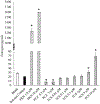Evaluation of triclosan in the Hershberger and H295R steroidogenesis assays
- PMID: 29501854
- PMCID: PMC6713194
- DOI: 10.1016/j.toxlet.2018.03.001
Evaluation of triclosan in the Hershberger and H295R steroidogenesis assays
Abstract
Triclosan (TCS) is an antibacterial widely used in personal care products that exhibits endocrine disrupting activity in several species, with reports of altered thyroid, estrogen and androgen signaling pathways. To evaluate the androgenic mode of action, TCS was evaluated for androgen receptor mediated effects in the Hershberger assay and for altered androgen synthesis in the H295R steroidogenesis assay. In the Hershberger assay, castrated males were dosed by oral gavage for 10 days with corn oil (vehicle) or TCS (50 or 200 mg/kg/day) in the presence or absence of testosterone proprionate (TP, 0.2 mg/kg/day) prior to assessing accessory sex tissues (ASTs) weights. TCS alone or in combination with TP did not alter androgen dependent AST weights. Assessment of serum thyroxine (T4) demonstrated a significant dose-dependent decrease by TCS (50 or 200 mg/kg/day) co-administered with TP and TCS (200 mg/kg) without TP, but no differences in liver or thyroid weights. In the H295R assay, TCS from 0.01 to 10 μM had no effect on testosterone production but TCS at 3 μM and above did induce a significant increase in estrogen production. At 10 μM, TCS produced significant cytotoxicity which confounded the interpretation of the estrogenic effect at that concentration. Thus, TCS had no effect on androgen synthesis or activity in the models used, but did enhance estrogen production and suppress serum T4.
Keywords: Endocrine disruptor; H295R; Hershberger; Steroidogenesis; Triclosan.
Published by Elsevier B.V.
Figures





Similar articles
-
Comparison of anti-androgenic activity of flutamide, vinclozolin, procymidone, linuron, and p, p'-DDE in rodent 10-day Hershberger assay.Toxicology. 2004 Jul 1;199(2-3):145-59. doi: 10.1016/j.tox.2004.02.019. Toxicology. 2004. PMID: 15147789
-
OECD validation of phase-3 Hershberger assay using the stimulated weanling male rat in Korea.J Appl Toxicol. 2010 May;30(4):361-8. doi: 10.1002/jat.1506. J Appl Toxicol. 2010. PMID: 20082360
-
Enhanced rat Hershberger assay appears reliable for detection of not only (anti-)androgenic chemicals but also thyroid hormone modulators.Toxicol Sci. 2004 May;79(1):64-74. doi: 10.1093/toxsci/kfh093. Epub 2004 Feb 19. Toxicol Sci. 2004. PMID: 14976338
-
Critical analysis of endocrine disruptive activity of triclosan and its relevance to human exposure through the use of personal care products.Crit Rev Toxicol. 2014 Jul;44(6):535-55. doi: 10.3109/10408444.2014.910754. Epub 2014 Jun 4. Crit Rev Toxicol. 2014. PMID: 24897554 Review.
-
Development of a curated Hershberger database.Reprod Toxicol. 2018 Oct;81:259-271. doi: 10.1016/j.reprotox.2018.08.016. Epub 2018 Sep 8. Reprod Toxicol. 2018. PMID: 30205136 Free PMC article. Review.
Cited by
-
Quantification of the Uncertainties in Extrapolating From In Vitro Androgen Receptor Antagonism to In Vivo Hershberger Assay Endpoints and Adverse Reproductive Development in Male Rats.Toxicol Sci. 2020 Aug 1;176(2):297-311. doi: 10.1093/toxsci/kfaa067. Toxicol Sci. 2020. PMID: 32421828 Free PMC article.
-
Triclocarban, Triclosan, Bromochlorophene, Chlorophene, and Climbazole Effects on Nuclear Receptors: An in Silico and in Vitro Study.Environ Health Perspect. 2020 Oct;128(10):107005. doi: 10.1289/EHP6596. Epub 2020 Oct 16. Environ Health Perspect. 2020. PMID: 33064576 Free PMC article.
-
A systematic review and meta-analysis of the impact of triclosan exposure on human semen quality.Front Toxicol. 2024 Oct 17;6:1469340. doi: 10.3389/ftox.2024.1469340. eCollection 2024. Front Toxicol. 2024. PMID: 39483697 Free PMC article.
-
Triclosan: An Update on Biochemical and Molecular Mechanisms.Oxid Med Cell Longev. 2019 May 2;2019:1607304. doi: 10.1155/2019/1607304. eCollection 2019. Oxid Med Cell Longev. 2019. PMID: 31191794 Free PMC article. Review.
References
-
- Adolfsson-Erici M, Pettersson M, Parkkonen J, Sturve J, 2002. Triclosan: a commonly used bactericide found in human milk and in the aquatic environment in Sweden. Chemosphere 46, 1485–1489. - PubMed
-
- Axelstad M, Boberg J, Vinggaard AM, Christiansen S, Hass U, 2013. Triclosan exposure reduces thyroxine levels in pregnant and lactating rat dams and in directly exposed offspring. Food Chem. Toxicol 59, 534–540. - PubMed
-
- Christen V, Crettaz P, Oberli-Schrammli A, Fent K, 2010. Some flame retardants and the antimicrobials triclosan and triclocarban enhance the androgenic activity in vitro. Chemosphere 81, 1245–1252. - PubMed
MeSH terms
Substances
Grants and funding
LinkOut - more resources
Full Text Sources
Other Literature Sources

